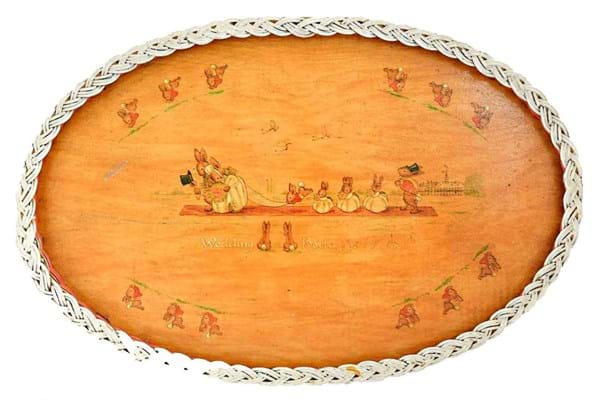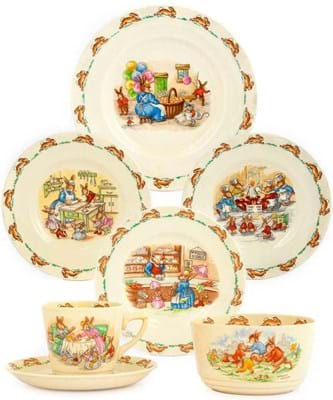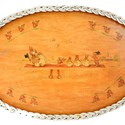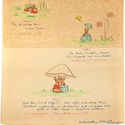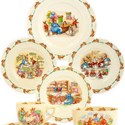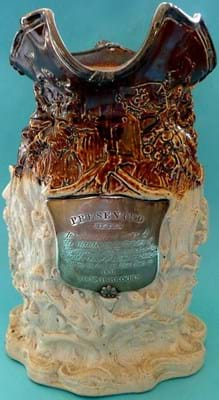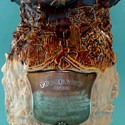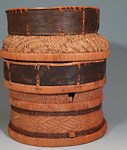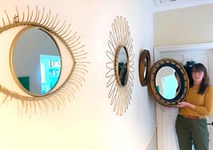
Done but not out, a badly damaged exhibition vase by the Burmantofts factory – £560 at 1818 Auctioneers.
Bidders peruse catalogues – sometimes in print, more often these days online – to find the lots they are interested in. They might contact the auctioneer for more information and attend a viewing before deciding whether to bid, though since the Covid pandemic more buyers have been happy to bid sight unseen.
Auction formats have become more varied in the past two years. Live online-only sales, for example, became an important method of selling during lockdowns with an auctioneer on the rostrum taking bids from online bidders who compete against phone and commission bidders but with no bidders on premises. Some firms still use this format today even now that lockdowns have ended.
More firms are also using timed online sales as part of their regular roster to complement their calendar of live sales. All the bidding in these sales is conducted remotely via the internet but with buyers able to consider their bids over a number of days. Typically, auction houses have used this format for lower value items but they are increasingly finding that higher priced lots will also do well in timed sales.
The traditional live sales which take place with bidding in the room, on the phone, on commission and online returned as soon as Covid restrictions ended and remain popular – not just for the higher value lots but for objects across all price points.
Described below are three items that sold recently for under £1000, each one in a different auction format. All three auctions were available for bidding on thesaleroom.com.
Timed online
In a blog post earlier this year Bill Nelson, saleroom manager at 1818 Auctioneers in Milnthorpe, Cumbria, wrote: “I may be biased but the greatest job in the world is working in an auction house. No matter your role, the joy of a find cannot be surpassed, from a discovery made on an appraisal visit to unearthing an item’s provenance.
“There’s also the pleasure of seeing an item you’ve brought in and catalogued for sale catching the eye of a buyer. It doesn’t have to be a high-value item, rather something that deeply interests them, be it a vintage dress or a fountain pen.”
Eye-catching
At 1818 Auctioneers (22.5% buyer’s premium inc VAT) all sales use the timed online format on thesaleroom.com and with the auction house holding way more than 100 auctions a year, there is always something to bid on.
Most auctions run for more than two weeks, with viewing held on a number of days during the period in which the auction is open for bidding. There is also an option to book a separate viewing slot by appointment.
One item that caught the eye of a number of bidders in a sale that ran from November 3-21 last year was a particular vase, here is the history behind it:
Perhaps the most admired wares of the Burmantofts Pottery in Leeds are the so-called Anglo-Persian range of vases and plaques.
The best of these low-fired wares in the Isnik palette carry the initials LK that the 1891 census records suggest is a factory worker by the name of Leonard King. He remains an enigma (until relatively recently LK had acquired the more exotic moniker Louis Kramer), but he was hugely skilful.
The two pieces that hold the auction record of £13,000 for Burmantofts – the massive faience Neptune charger sold at Woolley & Wallis in June 2017 and a large vase sold in 2005 at Anderson & Garland in Newcastle – were both for wares with the LK mark.
Unfortunately, some time in its life the 2ft 1in (62cm) high vase pictured here had been involved in a minor tragedy. As a number of supplementary online snaps suggested, it had been dropped and the base wholly separated from the body.
That aside, it had much in its favour. The same somewhat grainy images revealed both the signature LK to the base and a curious ‘ice cream cone’ symbol, one thought to denote pieces made for the Royal Yorkshire Jubilee Exhibition in Saltaire in 1887. Saltaire was possibly the launch pad for the Anglo-Persian wares and the exhibition stand was something to behold. A 3ft 8in (1.02m) high vase now on display in the 1853 Gallery in Salts Mill was among the exhibits.
So, too, it seems was this vase that, estimated at £200-300, took £560.
Nelson’s blog post concluded: “It can be hard work in an auction house but the rewards and pleasure are without compare - and not necessarily financial. We have found a new home for a possession that will continue to be loved and cherished.”
Live auction
The still popular Royal Doulton Bunnykins range originated with artwork of Mary ‘Barbara Vernon’ Bailey (1910-2003).
The daughter of Cuthbert Bailey, the general manager of Doulton during the 1930s, she provided designs to the factory for nursery tablewares and figures that were worked up by Hubert Light and Charles Noke.
What is less well known is that ‘Barbara Vernon’ (her middle names appeared as a printed signature to many designs) was not a professional illustrator but, from the age of 19, a nun in the Augustinian Canonesses of the Lateran in Haywards Heath, West Sussex.
Often working in secret (the Reverend Mother did not approve and insisted the convent received no royalties), Sister Mary submitted hundreds of designs to the Burslem factory until she ceased painting in 1950. When her designs were withdrawn in 1952, the range was taken up by Doulton art director Walter Hayward.
However, just occasionally, Bailey could be persuaded to return to her much-loved world of zoomorphic rabbits.
The 20th Century Design live sale at Tennants in Leyburn (22% buyer’s premium + VAT) on February 26 included, alongside a group of Bunnykins earthenwares an oval wicker tray painted with a scene of a bride, groom and bridesmaid bunnies, within a border of red coated attendants.
Titled Wedding Bells and dated January 18, 1958, this and three watercolour drawings named Veni, Vidi and Vici were given as a wedding present to Vivian Sewell (neé Baker), a teacher at Barbara Vernon's convent school.
Estimated at £300-400, the lot took £650 via an online bid.
Live online only
Following the rejection of the Second Reform Bill by the House of Lords on October 8, 1831, riots ensued in many provincial towns and cities. Notable was Yeovil where the houses of a number of local dignitaries were sacked on October 22. Fearing further destruction, the local magistrates summoned the yeomanry of nearby Mudford who, although remaining just outside the town, helped quell the mob with their presence.
As a token of thanks for their ‘manly and forbearing character’ a series of 10in (25cm) saltglaze stoneware harvest jugs were commissioned from a local potter and given as gifts. Each moulded with agricultural produce and similar motifs, they were applied with a white-metal band to the rim and an escutcheon engraved with a presentation inscription.
Changing fashion
This example, to a Mr H Brooks, reads: Presented by the inhabitants of Yeovil & its vicinity in testimony of their approval of the conduct of the Mudford Troop of Yeoman Cavalry during the Riots in that Town in 1831. There was a time when these jugs brought several hundred pounds each but fashions change.
This one, with a hair crack to the base, took £95 on March 22 in a live online-only sale titled Commemoratives, Fairings, Staffordshire Pot Lids and Prattware held by Historical & Collectable (24% buyer’s premium including VAT) in Reading.
History remembers that the brave men of the Mudford militia survived the night unscathed – the worst injury incurred when one of the yeomanry shot himself in the leg.


